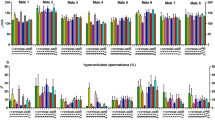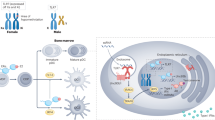Abstract
IT is generally considered that the Y chromosome is necessary for the development of the mammalian testis and the consequent male phenotype. Exceptions occasionally occur in man and other animals, where a male phenotype is associated with an apparently normal female karyotype. In some instances it has been possible to show that such “sex reversal” has an autosomal genetic basis. Although this might imply that the Y chromosome is not a prerequisite of maleness, it has not been excluded that a small male-determining region of the Y may have been translocated to an autosome without producing a recognisable karyotypic change1 (reviewed in ref. 2). The best studied case of male development with an apparently female karyotype is provided by the Sxr mutant in the mouse. This autosomal dominant condition causes both XX and XO mice to develop as males, although germ cells are absent in Sxr,XX animals and spermatogenesis is impaired in Sxr,XO mice. Sxr,XY males have a slightly reduced testis size but are usually fertile. Cytological scrutiny of mitotic and meiotic chromosomes (including chromosome banding) has revealed no evidence for a Y–autosome translocation, although a small translocation undetectable by the methods used cannot be ruled out (reviewed in ref. 2). This situation can now be investigated using serological methods for detecting H–Y (histocompatibility–Y) antigen on the surface of mouse sperm3 and male epidermal cells4. These techniques have provided further evidence that expression of this antigen is governed by a gene (or genes) on the Y chromosome even in the absence of the normal male phenotype5. Thus, serological demonstration of H–Y antigen offers a non-karyological criterion for the presence of a translocated portion of the Y in Sxr,XX males, because their cells should express H–Y if Sxr is a translocation involving the H–Y genetic determinant. We report here that Sxr,XX males express H–Y to a degree that may be the same or slightly lower than that of normal males, and that their Sxr,XY siblings seem to have near-normal levels of H–Y. The simplest explanation is that male-determining and H–Y-determining portions of the Y chromosome are present in the animals carrying Sxr.
This is a preview of subscription content, access via your institution
Access options
Subscribe to this journal
Receive 51 print issues and online access
$199.00 per year
only $3.90 per issue
Buy this article
- Purchase on Springer Link
- Instant access to full article PDF
Prices may be subject to local taxes which are calculated during checkout
Similar content being viewed by others
References
Cattanach, B. M., Pollard, C. E., and Hawkes, S. G., Cytogenetics, 10, 318 (1971).
Cattanach, B. M., in The Early Development of Mammals (edit. by Balls, M., and Wild, A.) (Cambridge University Press, Cambridge, 1975).
Goldberg, E. H., Boyse, E. A., Bennett, D., Scheid, M., and Carswell, E. A., Nature, 232, 478 (1972).
Scheid, M., Boyse, E. A., Carwell, E. A., and Old, L. J., J. exp. Med., 1357, 938 (1972).
Bennett, D., et al., Nature, 257, 236 (1975).
Cattanach, B. M., In, Birth Defects, Proc. Fourth Inf. Conf., (edit. by Motulsky, A. G., and Lentz, W.), (Excerpta Medica, Amsterdam, 1973).
Lyon, M. F., Scient. Prog., 58. 117 (1970).
Billingham, R. E. and Medawar, P. B., J. exp. Biol., 28, 385 (1951).
Litchfield, J. T., Pharmac. exp. Ther., 971 399, (1949).
Author information
Authors and Affiliations
Rights and permissions
About this article
Cite this article
BENNETT, D., MATHIESON, B., SCHEID, M. et al. Serological evidence for H–Y antigen in Sxr, XX sex-reversed phenotypic males. Nature 265, 255–257 (1977). https://doi.org/10.1038/265255a0
Received:
Accepted:
Issue Date:
DOI: https://doi.org/10.1038/265255a0
This article is cited by
-
Separation of the genetic loci for the H–Y antigen and for testis determination on human Y chromosome
Nature (1987)
-
Spermatogenic failure in male mice lacking H–Y antigen
Nature (1986)
-
Male sexual differentiation in mice lacking H–Y antigen
Nature (1984)
-
Variability in serologically detected male antigen titer and some resulting problems: A critical review
Human Genetics (1984)
Comments
By submitting a comment you agree to abide by our Terms and Community Guidelines. If you find something abusive or that does not comply with our terms or guidelines please flag it as inappropriate.



